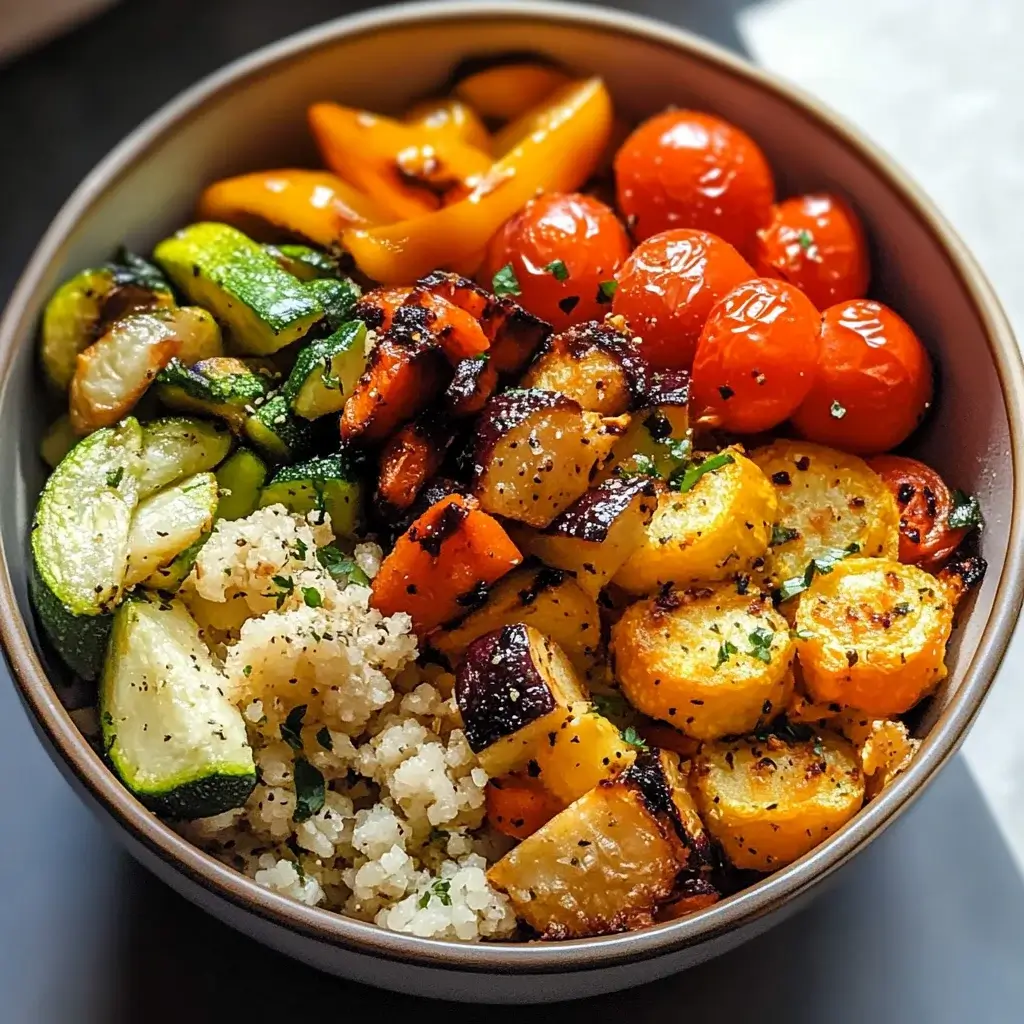It’s funny how some of the simplest recipes can become absolute staples in our homes. This Healthy Vegetarian Roasted Veggie Bowl is one of those gems for my family. Initially, I was looking for a way to get more vegetables into our diets without the usual complaints. Roasting, I knew, was key to unlocking the natural sweetness and depth of flavor in vegetables, but I wasn’t sure if it would be enough to win over my picky eaters. Boy, was I wrong! The first time I made these bowls, the aroma alone had everyone gathered in the kitchen. The vibrant colors of the roasted vegetables, combined with the nutty quinoa and a drizzle of creamy tahini dressing, were instantly appealing. Even my kids, who usually turn their noses up at anything green, devoured their bowls. Now, it’s a regular request, and I love how customizable and easy it is to prepare. It’s become our go-to for a healthy, satisfying, and utterly delicious meal that everyone enjoys, and I’m excited to share this recipe with you so it can become a favorite in your home too!
Ingredients for Healthy Vegetarian Roasted Veggie Bowls
- Sweet Potatoes: (2 large, peeled and cubed) – Offer a wonderful sweetness and creamy texture when roasted, packed with vitamin A and fiber.
- Broccoli Florets: (1 large head, cut into florets) – Roasts beautifully, becoming slightly charred and tender, a great source of vitamin C and antioxidants.
- Bell Peppers: (2, any color, seeded and chopped) – Add vibrant color and a slightly sweet flavor when roasted, rich in vitamins and flavor.
- Red Onion: (1 large, cut into wedges) – Roasting mellows its sharpness and brings out a sweet and savory flavor, adding depth to the bowl.
- Carrots: (3 large, peeled and chopped into rounds) – Sweeten and soften wonderfully when roasted, adding beta-carotene and texture.
- Zucchini: (2 medium, chopped into chunks) – Becomes tender and slightly sweet when roasted, adding a delicate flavor and moisture.
- Olive Oil: (4 tablespoons) – Essential for roasting, helps vegetables caramelize and prevents sticking, also a source of healthy fats.
- Dried Herbs: (2 teaspoons mixed, such as oregano, thyme, rosemary) – Enhance the flavor of the vegetables with earthy and aromatic notes.
- Garlic Powder: (1 teaspoon) – Adds a savory depth to the vegetables, complementing the roasted flavors.
- Salt and Black Pepper: (To taste) – Essential seasonings, enhance the natural flavors of the vegetables.
- Quinoa: (1 cup, uncooked) – A nutritious base for the bowls, provides protein and fiber, cooks quickly and has a slightly nutty flavor.
- Vegetable Broth or Water: (2 cups) – Used to cook the quinoa, adding flavor if using broth.
- Tahini Dressing: (For drizzling, store-bought or homemade) – Adds a creamy, nutty, and slightly tangy element, perfectly complementing the roasted vegetables.
- Optional Toppings: (Fresh parsley, chopped nuts, seeds, avocado slices, lemon wedges) – Enhance the bowls with fresh flavors, textures, and added nutrients.
Instructions for Perfect Roasted Veggie Bowls
- Preheat Your Oven and Prepare Baking Sheets: Start by preheating your oven to 400°F (200°C). This high temperature is crucial for getting those beautifully caramelized and slightly crispy roasted vegetables. While the oven is heating, prepare two large baking sheets. Line them with parchment paper for easy cleanup and to prevent the vegetables from sticking, ensuring they roast rather than steam.
- Chop and Prep the Vegetables: Now it’s time to get your vegetables ready. Wash all your vegetables thoroughly. Peel the sweet potatoes and carrots, then chop them into bite-sized cubes or rounds, ensuring they are roughly the same size for even roasting. Cut the broccoli into florets, chop the bell peppers into chunks, and slice the red onion into wedges. For the zucchini, simply chop it into chunks. Uniformity in size is key to ensure all the vegetables cook at the same rate.
- Toss Vegetables with Olive Oil and Seasonings: In a large bowl, combine all the chopped vegetables: sweet potatoes, broccoli florets, bell peppers, red onion wedges, carrots, and zucchini. Drizzle 4 tablespoons of olive oil over the vegetables. Using your hands or a large spoon, toss the vegetables thoroughly to ensure they are evenly coated with the oil. This is important for caramelization and flavor development. Next, sprinkle the mixed dried herbs (oregano, thyme, rosemary), garlic powder, salt, and black pepper over the oiled vegetables. Toss again to distribute the seasonings evenly. Don’t be shy with the seasoning – it’s what will really make the flavors pop!
- Arrange Vegetables on Baking Sheets: Spread the seasoned vegetables in a single layer on the prepared baking sheets. Avoid overcrowding the pan, as this can cause the vegetables to steam instead of roast, resulting in less crispy and flavorful veggies. If necessary, use two baking sheets to ensure there’s enough space between the vegetables. Proper spacing allows for better air circulation and even roasting.
- Roast the Vegetables to Perfection: Place the baking sheets in the preheated oven and roast for 25-30 minutes, or until the vegetables are tender and slightly caramelized. About halfway through the roasting time, around 15 minutes in, take the baking sheets out of the oven and toss the vegetables with a spatula. This ensures even cooking and browning on all sides. Return the baking sheets to the oven and continue roasting until the vegetables are tender when pierced with a fork and have beautiful roasted edges. The roasting time may vary slightly depending on your oven and the size of your vegetable pieces, so keep an eye on them.
- Cook the Quinoa: While the vegetables are roasting, prepare the quinoa. Rinse 1 cup of uncooked quinoa in a fine-mesh sieve under cold water for a minute or two to remove any saponins, which can give it a bitter taste. In a medium saucepan, combine the rinsed quinoa with 2 cups of vegetable broth (or water). Bring the mixture to a boil over high heat, then reduce the heat to low, cover the pot, and simmer for 15-20 minutes, or until all the liquid is absorbed and the quinoa is cooked through. Fluff the cooked quinoa with a fork and set aside.
- Assemble Your Roasted Veggie Bowls: Once the vegetables are roasted and the quinoa is cooked, it’s time to assemble your bowls. Divide the cooked quinoa evenly among bowls. Top the quinoa with generous portions of the roasted vegetables. Arrange them artfully for a visually appealing bowl.
- Drizzle with Tahini Dressing and Add Toppings: The final touch that brings everything together is the tahini dressing. Drizzle a generous amount of tahini dressing over the roasted vegetables and quinoa in each bowl. The creamy, nutty dressing perfectly complements the roasted flavors. For extra flavor, texture, and nutrients, add your optional toppings. Sprinkle with fresh parsley for freshness, chopped nuts or seeds for crunch and healthy fats, avocado slices for creaminess and healthy fats, and lemon wedges for a bright, citrusy finish.
- Serve and Enjoy Immediately: Serve your Healthy Vegetarian Roasted Veggie Bowls immediately while the vegetables are warm and the quinoa is fluffy. These bowls are delicious served warm, but they can also be enjoyed at room temperature or even cold, making them great for meal prep and lunches. Enjoy the vibrant flavors and textures of your wholesome and satisfying roasted veggie bowls!
Nutrition Facts for Healthy Vegetarian Roasted Veggie Bowls (per serving)
(Note: Nutritional values are approximate and can vary based on specific ingredients and serving sizes.)
- Serving Size: 1 bowl (approx. 1.5 cups)
- Calories: Approximately 450-550 kcal
- Protein: 12-15g
- Fiber: 10-12g
Preparation Time for Roasted Veggie Bowls
This recipe is wonderfully efficient, perfect for busy weeknights or when you want a healthy meal without spending hours in the kitchen.
- Prep Time: 20-25 minutes (This includes washing, peeling, and chopping all the vegetables, as well as preparing the quinoa for cooking.)
- Cook Time: 25-30 minutes (Roasting vegetables in the oven and simmering quinoa simultaneously.)
- Total Time: Approximately 45-55 minutes (From start to finish, you’ll have a delicious and nutritious meal ready in under an hour!)
This timeframe makes it an excellent option for a quick and healthy dinner. You can even save time by prepping the vegetables in advance – chop them ahead of time and store them in the refrigerator until you’re ready to roast.
How to Serve Your Roasted Veggie Bowls
These Roasted Veggie Bowls are incredibly versatile and can be served in numerous delicious ways. Here are some ideas to inspire you:
- Warm and Cozy: Serve the bowls immediately after roasting for a warm and comforting meal, perfect for cooler evenings. The warmth enhances the flavors and creates a satisfyingly hearty dish.
- Room Temperature for Lunch: These bowls are fantastic for meal prepping lunches. Prepare them ahead of time and enjoy them at room temperature. The flavors meld together beautifully as they sit, making them a delicious and convenient midday meal.
- Cold as a Salad: For a refreshing twist, chill the roasted vegetables and quinoa completely and serve as a cold salad bowl, especially enjoyable during warmer months. The cold vegetables retain their flavor and texture, creating a light yet filling salad.
- With Added Protein: Boost the protein content by adding:
- Roasted Chickpeas: Toss chickpeas with olive oil and spices and roast alongside the vegetables for added protein and crunch.
- Grilled or Baked Tofu: Cubed and seasoned tofu can be grilled or baked and added to the bowls for a substantial protein source.
- Lentils: Cooked lentils can be mixed into the quinoa or served as a layer in the bowl, providing a plant-based protein boost.
- Edamame: Steamed or roasted edamame adds a pop of green and extra protein.
- Grain Variations: Experiment with different grains instead of quinoa:
- Brown Rice: Offers a chewy texture and nutty flavor.
- Farro: Provides a hearty and slightly nutty taste with a satisfying bite.
- Couscous: For a lighter and fluffier base.
- Bulgur Wheat: Adds a nutty flavor and slightly chewy texture.
- Dressing Alternatives: While tahini dressing is delicious, try other dressings for variety:
- Lemon-Herb Vinaigrette: A bright and tangy vinaigrette to complement the roasted vegetables.
- Balsamic Glaze: A sweet and tangy drizzle for added depth of flavor.
- Spicy Peanut Sauce: For an Asian-inspired twist, a creamy and spicy peanut sauce works wonderfully.
- Green Goddess Dressing: A herby and creamy dressing for a fresh flavor profile.
- Topping Variations: Get creative with your toppings:
- Fresh Herbs: Parsley, cilantro, dill, or mint add freshness and aroma.
- Nuts and Seeds: Toasted almonds, pecans, walnuts, pumpkin seeds, or sunflower seeds for crunch and healthy fats.
- Avocado or Guacamole: For creaminess and healthy fats.
- Feta Cheese (optional, for non-vegans): Crumbled feta adds a salty and tangy flavor.
- Sprouts: Alfalfa, broccoli, or radish sprouts for added nutrients and texture.
- Pickled Onions or Red Cabbage: For a tangy and crunchy element.
Additional Tips for the Best Roasted Veggie Bowls
To elevate your Roasted Veggie Bowls from good to absolutely fantastic, here are some additional tips and tricks:
- Don’t Overcrowd the Baking Sheet: This is crucial for achieving perfectly roasted vegetables. Overcrowding causes steaming instead of roasting, resulting in soggy vegetables. Use two baking sheets if necessary to spread the vegetables in a single layer with space between them. This allows for proper air circulation and even caramelization.
- Cut Vegetables to a Uniform Size: Ensure all your vegetables are cut into roughly the same size pieces. This is essential for even cooking. Larger pieces will take longer to roast, while smaller pieces might burn before the larger ones are cooked through. Uniformity ensures everything is tender and perfectly roasted at the same time.
- Preheat the Baking Sheet (Optional): For extra crispy edges, you can preheat your baking sheet in the oven while it preheats. Carefully place the vegetables on the hot baking sheet. This initial contact with the hot surface can help create a nice sear and crispiness, especially for vegetables like sweet potatoes and broccoli.
- Toss Vegetables Halfway Through Roasting: Don’t just put the vegetables in the oven and forget about them. Tossing them halfway through ensures even cooking and browning on all sides. Use a spatula to gently flip and redistribute the vegetables on the baking sheet. This helps them roast uniformly and prevents sticking.
- Adjust Roasting Time Based on Vegetables: Different vegetables have different roasting times. Root vegetables like sweet potatoes and carrots take longer, while softer vegetables like zucchini and bell peppers cook faster. You can adjust the roasting time accordingly or even add quicker-cooking vegetables later in the roasting process if needed. Observe the vegetables and adjust cooking time as necessary to achieve desired tenderness.
- Season Generously and Layer Flavors: Don’t be shy with your seasonings. Salt and pepper are essential, but also experiment with other herbs and spices. Garlic powder, onion powder, paprika, cumin, chili powder, or Italian seasoning blends can all add depth and complexity. Consider adding a squeeze of lemon juice or a splash of balsamic vinegar after roasting to brighten the flavors. Layering flavors elevates the dish.
- Make Ahead Components for Easy Assembly: Roasted vegetables are delicious fresh, but they also hold up well for meal prep. You can roast the vegetables and cook the quinoa ahead of time. Store them separately in airtight containers in the refrigerator. When you’re ready to eat, simply reheat the vegetables and quinoa (or enjoy them cold) and assemble your bowls. This makes meal assembly quick and easy, especially during busy weekdays.
- Customize with Seasonal Vegetables: Roasted Veggie Bowls are incredibly versatile and can be adapted to any season. Use seasonal vegetables for the freshest and most flavorful bowls. In the fall and winter, try butternut squash, Brussels sprouts, parsnips, and root vegetables. In spring and summer, incorporate asparagus, green beans, corn, and summer squash. Experiment with different vegetable combinations throughout the year to keep the recipe exciting and aligned with what’s fresh and available.
Frequently Asked Questions (FAQ) About Roasted Veggie Bowls
Q1: Can I use frozen vegetables for roasting?
A: While fresh vegetables are ideal for roasting, you can use frozen vegetables in a pinch. However, keep in mind that frozen vegetables tend to release more moisture, which can lead to less crispy results. To use frozen vegetables, thaw them slightly and pat them dry thoroughly before tossing with oil and seasonings. You may need to roast them for a slightly longer time to ensure they are cooked through and to allow some of the excess moisture to evaporate. Broccoli and bell peppers tend to roast better from frozen than softer vegetables like zucchini.
Q2: How can I make these bowls vegan?
A: These bowls are naturally vegetarian, and making them vegan is incredibly easy! Simply ensure your tahini dressing is vegan-friendly (most are, but always check the ingredients). Omit any optional toppings like feta cheese, and you have a completely delicious and satisfying vegan meal. These bowls are already plant-based and packed with nutrients, making them a fantastic vegan option.
Q3: Can I prepare the roasted vegetables ahead of time?
A: Absolutely! Roasted vegetables are perfect for meal prep. You can roast them up to 3-4 days in advance and store them in an airtight container in the refrigerator. Reheat them in the oven, microwave, or enjoy them cold. Roasting vegetables ahead of time is a great way to save time during the week and have healthy components ready for quick meal assembly.
Q4: What other vegetables can I use in these bowls?
A: The beauty of roasted veggie bowls is their versatility! Feel free to experiment with any vegetables you enjoy or have on hand. Great additions include: Brussels sprouts, cauliflower, parsnips, beets, radishes, asparagus, green beans, eggplant, mushrooms, and cherry tomatoes. Get creative and use seasonal vegetables for the best flavor and variety.
Q5: Can I add protein to make it a more substantial meal?
A: Yes, definitely! You can easily boost the protein content of these bowls. Excellent protein additions include: roasted chickpeas, grilled or baked tofu, lentils, edamame, tempeh, or even a fried or poached egg (if not strictly vegan). Adding protein will make the bowls even more filling and satisfying, perfect for a main course.
Q6: How do I store leftover roasted veggie bowls?
A: Store leftover roasted vegetables and cooked quinoa separately or assembled in bowls in airtight containers in the refrigerator for up to 3-4 days. Reheat the vegetables and quinoa in the oven, microwave, or enjoy them cold. The dressing is best added just before serving to maintain the best texture.
Q7: Can I make this recipe gluten-free?
A: Yes, this recipe is naturally gluten-free as long as you ensure your quinoa is certified gluten-free (though quinoa is naturally gluten-free, cross-contamination can sometimes occur during processing). All the other ingredients – vegetables, olive oil, herbs, spices, and tahini dressing – are naturally gluten-free. Double-check the ingredients of your tahini dressing to be certain if you have strict gluten sensitivities.
Q8: What if I don’t like tahini dressing? What are other dressing options?
A: If tahini dressing isn’t your favorite, there are many other delicious dressing options! Try a lemon-herb vinaigrette, balsamic vinaigrette, a creamy avocado dressing, a spicy peanut sauce, a green goddess dressing, or simply a drizzle of olive oil and lemon juice. Experiment with different dressings to find your perfect flavor combination and to keep the bowls exciting and varied.
Print
Healthy Vegetarian Roasted Veggie Bowls
Ingredients
- Sweet Potatoes: (2 large, peeled and cubed) – Offer a wonderful sweetness and creamy texture when roasted, packed with vitamin A and fiber.
- Broccoli Florets: (1 large head, cut into florets) – Roasts beautifully, becoming slightly charred and tender, a great source of vitamin C and antioxidants.
- Bell Peppers: (2, any color, seeded and chopped) – Add vibrant color and a slightly sweet flavor when roasted, rich in vitamins and flavor.
- Red Onion: (1 large, cut into wedges) – Roasting mellows its sharpness and brings out a sweet and savory flavor, adding depth to the bowl.
- Carrots: (3 large, peeled and chopped into rounds) – Sweeten and soften wonderfully when roasted, adding beta-carotene and texture.
- Zucchini: (2 medium, chopped into chunks) – Becomes tender and slightly sweet when roasted, adding a delicate flavor and moisture.
- Olive Oil: (4 tablespoons) – Essential for roasting, helps vegetables caramelize and prevents sticking, also a source of healthy fats.
- Dried Herbs: (2 teaspoons mixed, such as oregano, thyme, rosemary) – Enhance the flavor of the vegetables with earthy and aromatic notes.
- Garlic Powder: (1 teaspoon) – Adds a savory depth to the vegetables, complementing the roasted flavors.
- Salt and Black Pepper: (To taste) – Essential seasonings, enhance the natural flavors of the vegetables.
- Quinoa: (1 cup, uncooked) – A nutritious base for the bowls, provides protein and fiber, cooks quickly and has a slightly nutty flavor.
- Vegetable Broth or Water: (2 cups) – Used to cook the quinoa, adding flavor if using broth.
- Tahini Dressing: (For drizzling, store-bought or homemade) – Adds a creamy, nutty, and slightly tangy element, perfectly complementing the roasted vegetables.
- Optional Toppings: (Fresh parsley, chopped nuts, seeds, avocado slices, lemon wedges) – Enhance the bowls with fresh flavors, textures, and added nutrients.
Instructions
- Preheat Your Oven and Prepare Baking Sheets: Start by preheating your oven to 400°F (200°C). This high temperature is crucial for getting those beautifully caramelized and slightly crispy roasted vegetables. While the oven is heating, prepare two large baking sheets. Line them with parchment paper for easy cleanup and to prevent the vegetables from sticking, ensuring they roast rather than steam.
- Chop and Prep the Vegetables: Now it’s time to get your vegetables ready. Wash all your vegetables thoroughly. Peel the sweet potatoes and carrots, then chop them into bite-sized cubes or rounds, ensuring they are roughly the same size for even roasting. Cut the broccoli into florets, chop the bell peppers into chunks, and slice the red onion into wedges. For the zucchini, simply chop it into chunks. Uniformity in size is key to ensure all the vegetables cook at the same rate.
- Toss Vegetables with Olive Oil and Seasonings: In a large bowl, combine all the chopped vegetables: sweet potatoes, broccoli florets, bell peppers, red onion wedges, carrots, and zucchini. Drizzle 4 tablespoons of olive oil over the vegetables. Using your hands or a large spoon, toss the vegetables thoroughly to ensure they are evenly coated with the oil. This is important for caramelization and flavor development. Next, sprinkle the mixed dried herbs (oregano, thyme, rosemary), garlic powder, salt, and black pepper over the oiled vegetables. Toss again to distribute the seasonings evenly. Don’t be shy with the seasoning – it’s what will really make the flavors pop!
- Arrange Vegetables on Baking Sheets: Spread the seasoned vegetables in a single layer on the prepared baking sheets. Avoid overcrowding the pan, as this can cause the vegetables to steam instead of roast, resulting in less crispy and flavorful veggies. If necessary, use two baking sheets to ensure there’s enough space between the vegetables. Proper spacing allows for better air circulation and even roasting.
- Roast the Vegetables to Perfection: Place the baking sheets in the preheated oven and roast for 25-30 minutes, or until the vegetables are tender and slightly caramelized. About halfway through the roasting time, around 15 minutes in, take the baking sheets out of the oven and toss the vegetables with a spatula. This ensures even cooking and browning on all sides. Return the baking sheets to the oven and continue roasting until the vegetables are tender when pierced with a fork and have beautiful roasted edges. The roasting time may vary slightly depending on your oven and the size of your vegetable pieces, so keep an eye on them.
- Cook the Quinoa: While the vegetables are roasting, prepare the quinoa. Rinse 1 cup of uncooked quinoa in a fine-mesh sieve under cold water for a minute or two to remove any saponins, which can give it a bitter taste. In a medium saucepan, combine the rinsed quinoa with 2 cups of vegetable broth (or water). Bring the mixture to a boil over high heat, then reduce the heat to low, cover the pot, and simmer for 15-20 minutes, or until all the liquid is absorbed and the quinoa is cooked through. Fluff the cooked quinoa with a fork and set aside.
- Assemble Your Roasted Veggie Bowls: Once the vegetables are roasted and the quinoa is cooked, it’s time to assemble your bowls. Divide the cooked quinoa evenly among bowls. Top the quinoa with generous portions of the roasted vegetables. Arrange them artfully for a visually appealing bowl.
- Drizzle with Tahini Dressing and Add Toppings: The final touch that brings everything together is the tahini dressing. Drizzle a generous amount of tahini dressing over the roasted vegetables and quinoa in each bowl. The creamy, nutty dressing perfectly complements the roasted flavors. For extra flavor, texture, and nutrients, add your optional toppings. Sprinkle with fresh parsley for freshness, chopped nuts or seeds for crunch and healthy fats, avocado slices for creaminess and healthy fats, and lemon wedges for a bright, citrusy finish.
- Serve and Enjoy Immediately: Serve your Healthy Vegetarian Roasted Veggie Bowls immediately while the vegetables are warm and the quinoa is fluffy. These bowls are delicious served warm, but they can also be enjoyed at room temperature or even cold, making them great for meal prep and lunches. Enjoy the vibrant flavors and textures of your wholesome and satisfying roasted veggie bowls!
Nutrition
- Serving Size: one normal portion
- Calories: 550
- Fiber: 12g
- Protein: 15g






